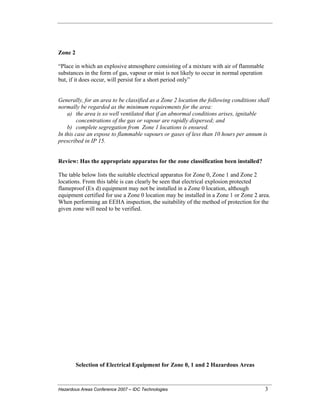Roar Solutions Things To Know Before You Get This
Wiki Article
All about Roar Solutions
Table of ContentsSome Known Facts About Roar Solutions.What Does Roar Solutions Do?The Single Strategy To Use For Roar Solutions
In order to safeguard setups from a potential explosion a technique of analysing and categorizing a possibly hazardous area is required. The purpose of this is to ensure the appropriate selection and installation of equipment to ultimately avoid an explosion and to guarantee safety of life.
(https://www.40billion.com/profile/91601565)
No devices should be installed where the surface temperature of the tools is higher than the ignition temperature of the provided hazard. Below are some common dust harmful and their minimal ignition temperature. Coal Dust 380C 225C Polythene 420C (melts) Methyl Cellulose 420C 320C Starch 460C 435C Flour 490C 340C Sugar 490C 460C Grain Dirt 510C 300C Phenolic Material 530C > 450C Aluminium 590C > 450C PVC 700C > 450C Soot 810C 570C The likelihood of the threat being existing in a focus high adequate to create an ignition will certainly differ from place to place.
In order to identify this risk a setup is split into areas of threat depending upon the amount of time the hazardous is present. These locations are described as Areas. For gases and vapours and dusts and fibres there are 3 zones. Zone 0 Area 20 A hazardous atmosphere is highly most likely to be existing and may exist for extended periods of time (> 1000 hours annually) or even continuously Area 1 Zone 21 A hazardous atmosphere is feasible yet unlikely to be present for extended periods of time (> 10 450 C [842 F] A category of T6 means the minimal ignition temperature level is > 85 C [185 F] Harmful area electrical equipment perhaps designed for usage in higher ambient temperature levels. This would indicated on the ranking plate e.g. EExe II C T3 Ta + 60C( This implies at 60C ambient T3 will not be gone beyond) T1 T1, T2, T3, T4, T5, T6 T2 T2, T3, T4, T5, T6 T3 T3, T4, T5, T6 T4 T4, T5, T6 T5 T5, T6 T6 T6 A T Class ranking of T1 implies the maximum surface area temperature generated by the tool at 40 C is 450 C. Thinking the linked T Course and Temperature level ranking for the equipment are proper for the area, you can constantly use a tool with a more rigorous Division ranking than required for the area. There isn't a clear response to this inquiry. It truly does depend on the kind of equipment and what fixings need to be executed. Devices with specific test treatments that can not be carried out in the area in order to achieve/maintain 3rd event ranking. Should come back to the factory if it is prior to the tools's service. Field Repair Service By Authorised Worker: Complicated testing may not be needed nonetheless certain treatments may need to be complied with in order for the tools to maintain its 3rd party ranking. Authorised workers have to be used to perform the work properly Repair service have to be a like for like substitute. New component should be considered as a straight replacement needing no special screening of the devices after the repair service is total. Each her response item of tools with a dangerous score must be assessed independently. These are laid out at a high degree below, but also for more comprehensive details, please refer directly to the guidelines.
The Definitive Guide to Roar Solutions
The tools register is an extensive data source of equipment documents that consists of a minimum set of areas to determine each product's area, technical specifications, Ex lover category, age, and environmental data. The proportion of In-depth to Close assessments will be identified by the Tools Threat, which is assessed based on ignition danger (the chance of a resource of ignition versus the probability of a flammable environment )and the hazardous area category( Zone 0Area 1, or 2). Executing a durable Risk-Based Evaluation( RBI )approach is vital for guaranteeing compliance and safety and security in managing Electric Equipment in Hazardous Areas( EEHA).
The Greatest Guide To Roar Solutions

In regards to explosive risk, an unsafe location is a setting in which an eruptive atmosphere exists (or might be expected to be existing) in amounts that call for special preventative measures for the construction, installation and use tools. hazardous area electrical course. In this post we check out the difficulties dealt with in the office, the risk control actions, and the required proficiencies to function safely
It is a repercussion of modern-day life that we manufacture, store or handle a series of gases or liquids that are considered combustible, and a variety of dusts that are considered flammable. These materials can, in specific problems, form explosive atmospheres and these can have significant and awful repercussions. Many of us know with the fire triangle get rid of any kind of one of the 3 aspects and the fire can not occur, yet what does this mean in the context of unsafe locations? When breaking this down right into its easiest terms it is essentially: a mix of a certain amount of release or leak of a certain compound or product, combining with ambient oxygen, and the presence of a resource of ignition.
In most circumstances, we can do little concerning the degrees of oxygen airborne, yet we can have considerable impact on resources of ignition, as an example electrical equipment. Harmful locations are recorded on the dangerous area category drawing and are identified on-site by the triangular "EX" sign. Right here, amongst various other vital info, areas are divided into 3 kinds relying on the hazard, the chance and period that an eruptive atmosphere will certainly exist; Area 0 or 20 is considered the most harmful and Area 2 or 22 is considered the least.
Report this wiki page